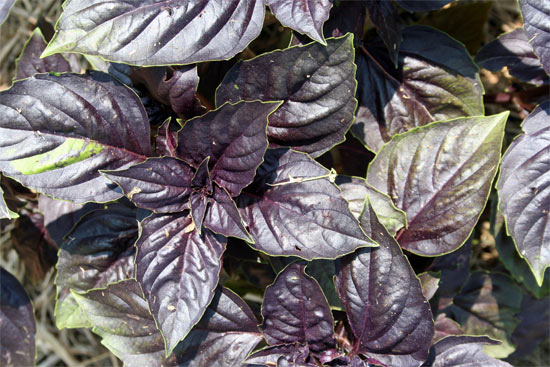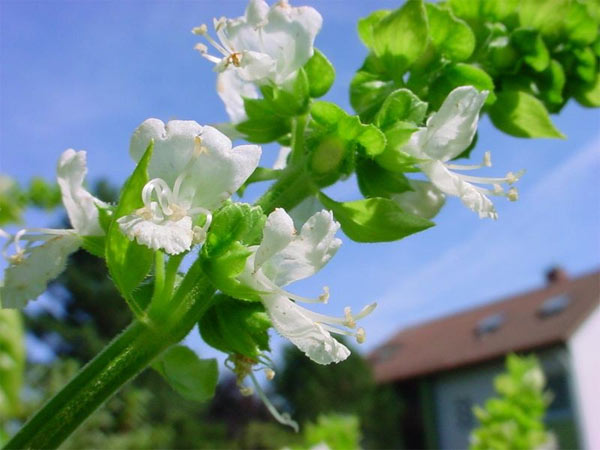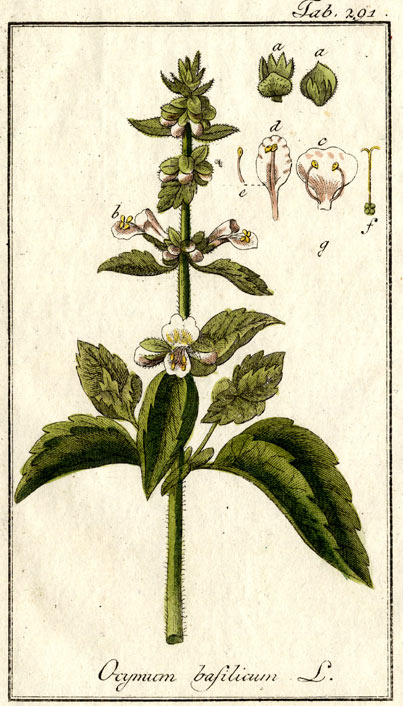A native of India and southeast Asia, basil probably came to Europe with the spice traders in Tudor times. Basil is referred to as the tomato herb because it goes so well with any dish containing tomatoes. Although studies have been done to show that when basil is grown next to tomatoes it does not affect their flavor.
In English-speaking countries it's sometimes referred to as St. Joseph's Wort. It is said that the Empress Helena, mother of Constantine, discovered holy basil (Ocimum tenuiflorum, slightly different than sweet basil) growing on the cross of Jesus when she visited the Holy Land in about 326 AD. This is the reason behind the Greek Orthodox church (and several other Orthodox Churches) using basil to prepare or sprinkle holy water, as well as placing pots of basil below their altars.
Basil is a common herb in Italian cooking (like pesto and tomato-based sauces), as well as South East Asian cuisines. Fresh basil has a very different (one could say more vibrant) flavor than the dried leaves. When used fresh it's usually added at the last minute as the flavor profile changes considerably with extended cooking. A unique way to cut fresh basil to prevent browning is to take 3-5 leaves, roll them into a fairly tight little cylinder, and use a very sharp knife to slice through the layers, pulling the knife toward you as you cut.
The different varieties of basil have different essential oils that give them unique smells and flavors. Common sweet basil has eugenol, giving it its clove-like scent. Lemon basil has limonene and citral, the same essential oils as found in lemon peels. Licorice basil has anethole, giving it a licorice-like scent.
The Mediterranean varieties are generally milder than the Asian ones, with holy basil being considered most notable for this. Holy basil, also known as tulsi, is a plant much revered and grown at home in India, Nepal, and China. Thai basil is generally more flavor-stable at higher temperatures and for longer cooking times than sweet basil.
Appearance
Sweet basil grows to about 2 feet in height with large, soft, ovate leaves, medium to light green in color. In midsummer white blossoms form on long spikes at the end of the stems. Bush basil is smaller in size, growing only to about 12 inches. It has smaller leaves than sweet basil but there are many more of them. It is altogether a more compact and bushy plant, as its name implies. Both of these basils are highly aromatic.
Varieties
Sweet and bush basil are the two most popular varieties. But there are so many other varieties that we won't attempt to list them here. Some of these are so different that they're actually considered different species or subspecies. These are some of the other varieties and species of basil you might find at garden centers or seed catalogs:
- Globe basil, dwarf basil, French basil (Ocimum basilicum var. 'Minimum')
- Lettuce leaf basil (Ocimum basilicum var. 'Crispum')
- Purple basil (Ocimum basilicum var. 'Purpurescens')
- Cinnamon basil (Ocimum basilicum var. 'Cinnamon')
- Holy basil (Ocimum tenuiflorum, formerly known a O. sanctum)
- Lemon basil (Ocimum americanum)
- Thai basil (Ocimum basilicum var. 'Horapha')
Propagation
Basil is easy to propagate from seed sown in a tray of potting compost and covered with a plastic bag or sheet of glass in March or April. A warm window-will is a good place to start basil growing, and usually the seed will germinate within a week. Transplanting can be done when the soil has warmed up. This should be done very carefully and the newly-planted basil given plenty of water. Basil seed can be sown outdoors, but this should not be attempted until early June when all danger of frosts has passed. When the seedlings are about 2 inches high, then out to about 8 inches apart.
Cultivation
Basil is an annual. It will thrive if planted in fairly rich soil that has been warmed by the sun. It likes a sheltered position, preferably with the protection of a hedge or wall. The plant grows quickly and needs plenty of water. If, as in many town gardens, the soil tends to dry out quickly, a mulch of compost around the plant will be helpful. It is very sensitive to cold and should only be planted outside when all danger of frost has passed.
Pests and Problems
Basil plants have a habit of growing rather straggly or leggy. to prevent this, snip off the top shoot when the plant is about 6 inches high. Remove the flower heads as they begin to form and you will get a more compact plant.
Fusarium wilt, a soil-borne fungus, can kill young sprouts and plants. Starting seeds or cuttings in sterilized soil is important to heading off this disease, as well as obtaining seed from known Fusarium-free sources.
Downy mildew, black spot, and gray mold are foliar diseases that can affect large areas of basil plantings. They can be significant problems for commercial crops of basil, as well as for the home gardener.
Harvesting and Storing
Basil leaves can be picked and used fresh at any time. The tops, picked earlier in the season, can be chopped and used in cooking. Basil is seldom dried since one usually grows accustomed to the flavor of the fresh leaves. They can, however, be dried if picked and laid out on a screen or tied up by their stems in a warm well ventilated place. Basil leaves can also be frozen by blanching with boiling water for a few seconds before freezing in ice cube trays.
Indoor or Patio Growing
Basil will grow very happily in a pot in the greenhouse or on a sunny window-sill. The pots should be at least 3 inches wide and contain a fairly rich compost mixture. If you have basil growing in the garden, pot up a couple of roots in early September and bring them inside. You can then keep the plants going until the end of November. A sunny patio is an ideal spot for growing basil, as well as a south-facing window box (in the northern hemisphere).
Images of Basil
 Thai basil (Ocimum basilicum var. 'Horapha'). Image from Wikimedia.
Thai basil (Ocimum basilicum var. 'Horapha'). Image from Wikimedia.
 Purple basil (Ocimum basilicum var. 'Purpurescens'). Image from Accokeek.
Purple basil (Ocimum basilicum var. 'Purpurescens'). Image from Accokeek.
 A closeup of the white flowers of basil. Image from Wikimedia.
A closeup of the white flowers of basil. Image from Wikimedia.
 Spicy globe basil (Ocimum basilicum var. 'Minimum').
Spicy globe basil (Ocimum basilicum var. 'Minimum').Image from Pantry Garden Herbs.

